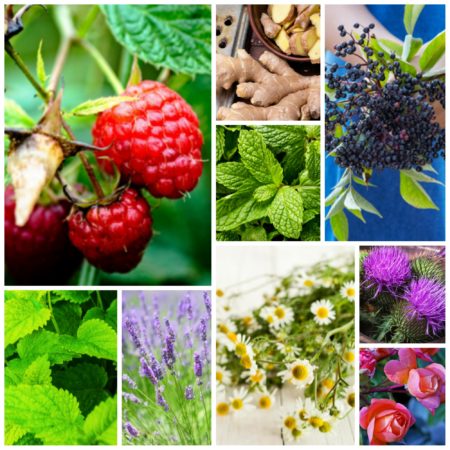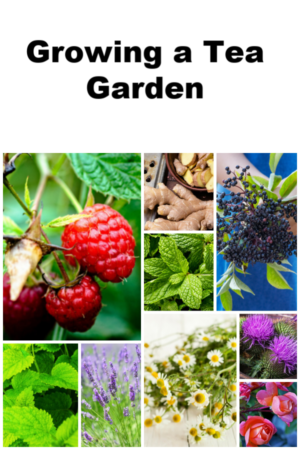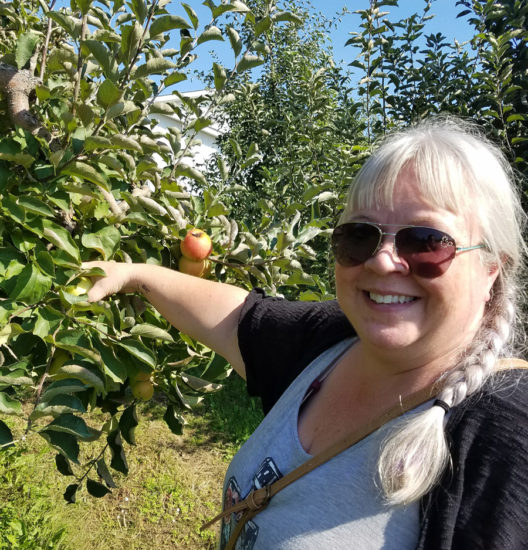
There are two things I’ve done quite a lot of this winter – Drink tea and learn about herbs. But then, that’s pretty typical for me almost any time of year.
And February, around here, is garden planning month. So it makes total sense to me to combine plants I already have growing here with some new plants to make my favorite beverage – TEA!
Not only will growing your own tea garden save you money but you will also know what is EXACTLY in, or on, your herbs, flowers, leaves. Having a pretty landscape is a BONUS!
Here is what I’m Growing in My Tea Garden:
Chamomile
We all know that chamomile tea helps us sleep at night, but did you also know it helps relieve stress, boosts immunity, eases cold symptoms, and soothes stomach aches. The flowers are beautiful and dainty and they add a wonderful texture to any garden.
Chamomile is a perennial and can be grown from an established plant or by seed. It is an easy herb to grow and can be grown in part shade or full sun, preferring cooler conditions. It likes dry soil and doesn’t require much care.
Mint
Who doesn’t love mint tea? There are so many different flavors of mint; the problem will be deciding what kind to plant. Peppermint, spearmint, apple mint, chocolate peppermint, or even Moroccan mint are just a few of the types of plants to pick from.
Don’t forget to keep mint contained, once planted it tends to take over the garden. I like to keep my mint in pots. Mint is a perennial and is relatively easy to grow. They do well in both shade and sun, with soil that has good drainage. Minimal care is needed to grow this amazing herb.
Rose
The taste and aroma of rose teas are heavenly. Rose leaves, buds, petals, and rose hips can all be used in making tea.
Most roses are edible, but there are some that are better suited for use in food and drink. You obviously wouldn’t want to add pesticides to your roses, so make sure you only use organic gardening methods.
When choosing which roses to grow, pick ones that have a pleasing scent. Old-fashioned fragrant heirloom roses work well. Yellow and pink roses usually have the most flavor and fragrance. Make sure you cut off the white part of the petal before using, it can cause a bitter taste.
Most roses need at least six hours of sun every day, so picking the right spot to plant them is important. Make sure they’re in well-draining soil and add 2-3 inches of organic mulch around the plants. Check regularly for disease or insects and prune regularly.
Elderberries
Elderberry trees produce both edible flowers and delicious fruits. The berries contain more vitamin C than oranges and are used to help boost the immune system.
Native to North America, elderberry trees can be found growing wild. The American Elderberry can grow up to 12 feet tall and wide. The plants start producing berries when they are two to three years old.
They love moist, well-drained soil and plenty of sunshine.
Milk thistle
Milk thistle is a herb that has anti-inflammatory and antiviral properties. It’s also filled with antioxidants.
Please note that milk thistle can be quite invasive, so make sure you plant it in a contained environment like pots. It likes sunny or lightly shaded areas.
Make sure its okay to grow milk thistle in your state. In some states, it’s considered a noxious weed and it is illegal to buy or sell plants. In my yard it grows anywhere and everywhere. It really does love a soil that is slightly acidic, and neighborhood bird feeders seem to supply plenty of seeds.
Lavender
I love anything and everything lavender. Lavender tea is divine. It also reduces anxiety and stress and helps with insomnia.
The plants need at least six hours a day and like a well-drained soil or raised beds. Don’t over water and make sure they have good air flow around the plants.
Lemon balm
Aiding with both insomnia and anxiety, lemon balm is a tea that will make you happy camper.
Part of the mint family, lemon balm looks like mint but smells like lemons. Plant lemon balm in well-drained soil where it will have some shade in the day. It can be invasive, so make sure to remove the flowers as soon as they appear to control growth. It does best in full-sun, but also grows in part shade. It’s an easy herb to grow.
Ginger
Ginger tea is so good for you. It helps reduce inflammation, improves blood circulation, relieves nausea and helps relieve stress.
Growing ginger root sounds like it would be hard, but with a couple of tips, its pretty easy. It loves filtered sunlight, a rich moist soil, warm weather, and humidity.
Raspberry Leaf
Raspberry leaf tea boosts the immune system, increases metabolism, helps regulate hormones, helps ease the symptoms of colds and flu and helps with inflammation. This tea is simply made from the leaves of raspberries by drying and crushing the leaves.
Make sure you pick the right plant type for your region. Raspberries love a good trellising system, love a good deep rich soil that drains well.
Tips for making tea:
- Make sure you harvest herbs before they flower. If you wait too long, they may turn bitter or lose their flavor.
- Cut herbs mid-morning. You want to make sure the morning dew has dried from the leaves.
- The best way to dry herbs is to air dry them. Tie small bunches of herbs upside down for a week or two, depending on your drying conditions.
- Drying is complete when the stems break easily, and the leaves crumble when crushed.
- Store herbs in airtight containers and label them. Keep them away from the sun and store them in a dry area. They will generally keep for a year.
- Use filtered water that is brought to a full boil
- Steep for several minutes. I steep my teas for a good 10-15 minutes
- Steep with a covering over the tea cup or tea pot. This keeps all of the essential oils in the tea.
Compost your Tea!
Don’t forget that a tea made with your own garden herbs or flowers can be composted. Just put the steeped leaves or flowers right in the bin.

